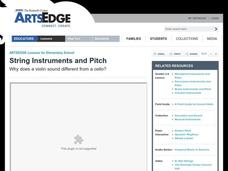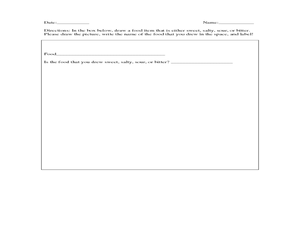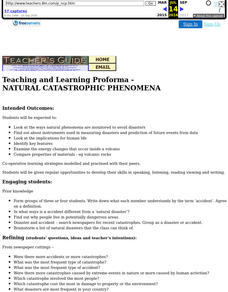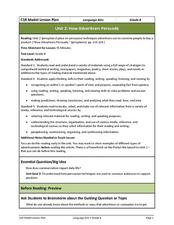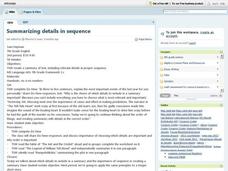Orange County Water Atlas
Location, Location, Location…
Young geographers discover not only how to read and recognize coordinates on a map, but also gain a deeper understanding of latitude and longitude and how climate changes can vary significantly across latitudes.
Curated OER
Reconstruction
Students describe the period of Reconstruction. Then students describe the concept of sharecropping. They complete a vocabulary prediction confirmation activity for the vocabulary words from the passage.
Curated OER
The Foot Book
Pupils use estimation and measurement skills to make predictions and solve problems about length. They also analyze data presented to calculate ratios and percents.
Curated OER
Measuring and Recording Weather
Students examine instruments used to measure weather, record the data, and post it to an online weather report. They include a 24 hour prediction, keep a weather log, and graph the data.
Curated OER
Trust
Students read and discuss Romeo and Juliet Act IV, Scenes 1 and 2. They compare the unfolding action with yesterday's predictions. They consider the concepts of trust, fate, and self-determination.
Curated OER
Does the Supreme Court Affect Teens?: A Survey of Court Cases
Students read and restate the Ten Amendements of the Bill of Rights. They analyze Supreme Court cases using the Bill of Rights. Students make predictions about how the Supreme Court might have deicided each case. They evaluate how the...
Curated OER
Home in the Desert: Lesson for Use with This House is Made of Mud
Third graders examine how a family modifies their environment to create a home out of mud. They read the book "This House is Made of Mud" by Ken Buchanan, and write a description of their own home that compares the home of mud to their...
Curated OER
Relatives
Primary learners read the text The Relatives Came and make text to self-connections. In this literature discussion, they discuss what the text reminds them of in their own lives. They can also write down their connections and share them.
Curated OER
How Germs Spread
Fourth graders investigate how germs spread in this lesson. They listen to "The Flea's Sneeze" by Lynn Downey and make predictions on why the hog began sneezing. They then conduct an experiment using flour and paper cups demonstrating...
Curated OER
String Instruments and Pitch
Students make predictions and explore how pitch is altered in string instruments. In this acoustic science lesson, students learn the types and parts of string instruments and create their own. They listen to classical music and identify...
Curated OER
Tracking Your Favorite Web Sites
Ninth graders track the hit count on their favorite web sites. In this Algebra I lesson, 9th graders record the number of hits on their favorite web site for twenty days. Students explore the data to determine if the relation defines a...
Curated OER
Terrific Taste Buds
Learners explore descriptive writing by eating food in class. In this descriptive word lesson, students assess different foods in class such as jelly beans and utilize their vocabulary to describe the taste. Learners read the story...
Curated OER
Cry, The Beloved Country: Anticipation Guide
“Poor people are poor because they are lazy and don’t work enough.” “If you are desperate, the means justify the ends.” Prior to reading Cry, The Beloved Country, class members complete an anticipation guide that focuses on issues raised...
Curated OER
Natural Catastrophic Phenomena
Sixth graders examine the ways natural phenomena are monitored to avoid disasters. They find out about instruments used in measuring disasters and prediction of future events from data.
Curated OER
How Advertisers Persuade
This plan centers around the article "How Advertisers Persuade," although it is not included in the instructional activity itself. Get your class thinking about advertising, appeals, and techniques that companies use to get their...
Museum of Tolerance
Family Tree Activity
Discover the family histories that make the classroom with a family tree activity. Scholars locate information about their family, construct a family tree, and work together to tally where family members are born.
Population Connection
The Peopling of Our Planet
How many people live on the planet, anyway? The first resource in a six-part series covers the topic of the world population. Scholars work in groups to conduct research and make population posters after learning about the global...
Curated OER
Mucket Mania: The Mussel Industry in Arkansas
Middle and high schoolers read and discuss articles about the mussel industry in Arkansas. They pay close attention to the history of pearling and button making industries on the Black and White Rivers of Arkansas. This impressive,...
Curated OER
Dependence of Light Intensity on Distance
Hopefully you have a sensor interface for your physics class to use with graphing calculators when collecting data with a light sensor. If so, read on. Use this resource for learners to predict and then test whether or not the intensity...
Curated OER
My First Book
Introduce young writers to the process of writing a book. Start by reading a book of your choice and discussing the essential elements of any book such as the cover, story, and illustrations as well as who is responsible for each...
PBS
Cardboard History
A PBS clip focused on collecting sports memorabilia launches this research project lesson. Class members then read Dan Gutman’s Honus and Me in which Wagner’s baseball card is used to time travel. The lesson ends with researchers...
Curated OER
Summarizing Details in Sequence
Seventh graders write a few sentences explaining the most important events of their lives during the past year. As a class, they discuss why they chose the elements they did for their sentences. To end the lesson, they read a variety of...
Curated OER
Cloudy With a Chance of Meatballs-Part I
Here is a lesson plan that gives learners a chance to practice using context clues. They read the story, Cloudy with a Chance of Meatballs. Students use different word strategies (base words, synonyms, antonyms) to decode and understand...
Curated OER
Scientific Method: How Many Drops of Water Fit on a Coin?
Young investigators conduct an experiment using the scientific method. They see how many drops of water fit on a coin; have them conduct several different trials. This involves making a hypothesis, looking at controls, and introducing...
Other popular searches
- Making Predictions Reading
- Predictions in Reading
- Making Predictions in Reading
- Reading Prediction Strategy
- Predictions Before Reading
- Reading Prediction Outcome
- Reading Prediction Skills
- Making Prediction in Reading
- Guided Reading Predictions
- Predictions Reading
- Prediction in Reading
- Prediction Reading











